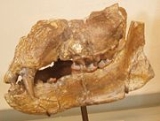
Plithocyon
Encyclopedia
Plithocyon is an extinct genus of bear-like hemicyonid
carnivore
of the Miocene
epoch, endemic to North America
and Europe
living from ~15.97—7.25 Ma, existing for approximately .
by Hunt (1998).
Hemicyonidae
Hemicyonidae is an extinct family of so-called "dog-bears", literally "Half Dog" , bear-like carnivoran living in Europe, North America, Africa, and Asia during the Oligocene through Miocene epochs 33.9—5.3 Ma, existing for approximately ....
carnivore
Carnivore
A carnivore meaning 'meat eater' is an organism that derives its energy and nutrient requirements from a diet consisting mainly or exclusively of animal tissue, whether through predation or scavenging...
of the Miocene
Miocene
The Miocene is a geological epoch of the Neogene Period and extends from about . The Miocene was named by Sir Charles Lyell. Its name comes from the Greek words and and means "less recent" because it has 18% fewer modern sea invertebrates than the Pliocene. The Miocene follows the Oligocene...
epoch, endemic to North America
North America
North America is a continent wholly within the Northern Hemisphere and almost wholly within the Western Hemisphere. It is also considered a northern subcontinent of the Americas...
and Europe
Europe
Europe is, by convention, one of the world's seven continents. Comprising the westernmost peninsula of Eurasia, Europe is generally 'divided' from Asia to its east by the watershed divides of the Ural and Caucasus Mountains, the Ural River, the Caspian and Black Seas, and the waterways connecting...
living from ~15.97—7.25 Ma, existing for approximately .
Taxonomy
Plithocyon was named by Ginsburg (1955). It was assigned to Ursidae by Ginsburg (1955) and Carroll (1988); and to HemicyoninaeHemicyoninae
Hemicyoninae is an extinct subfamily of bear-like mammals of the family Ursidae endemic to North America and Europe during Oligocene through Miocene, living from ~33.9—7.2 Ma, existing for approximately ....
by Hunt (1998).
Body mass
Two specimens were examined by Legendre and Roth for body mass.- Specimen 1: 79.3 kg (174.8 lb)
- Specimen 2: 652.6 kg (1,438.7 lb)
Fossil distribution
Sites and age of specimens:- Hemicyon Quarry, Barstow FormationBarstow FormationThe Barstow Formation is a series of limestones, conglomerates, sandstones, siltstones and shales exposed in the Mojave Desert near Barstow, California. It is early to middle Miocene in age, and lends its name to the Barstovian North American land mammal age...
, San Bernardino County, CaliforniaSan Bernardino County, CaliforniaSan Bernardino County is a county in the U.S. state of California. As of the 2010 census, the population was 2,035,210, up from 1,709,434 as of the 2000 census...
~13.7—11.6 Ma. - Ruby River Basin No.5, Madison County, MontanaMadison County, Montana-National protected areas:*Beaverhead National Forest *Deerlodge National Forest *Gallatin National Forest -Demographics:As of the census of 2000, there were 6,851 people, 2,956 households, and 1,921 families residing in the county. The population density was 2 people per square mile...
~23—5.3 Ma. - Pasalar site, Bursa, TurkeyBursa, TurkeyBursa is a city in northwestern Turkey and the seat of Bursa Province. The metropolitan area in the entire Bursa province had a population of 2.6 million as of 2010, making the city fourth most populous in Turkey. The city is equally one of the most industrialized metropolitan centers in the...
~16—13.7 Ma. - Pontigne site, FranceFranceThe French Republic , The French Republic , The French Republic , (commonly known as France , is a unitary semi-presidential republic in Western Europe with several overseas territories and islands located on other continents and in the Indian, Pacific, and Atlantic oceans. Metropolitan France...
~11.6—7.2 Ma.
Species
- Plithocyon antunesi Ginsburg & Morales, 1998
- Plithocyon armagnacensis Ginsburg, 1955
- Plithocyon barstowensis (Frick, 1926)
- Plithocyon bruneti Ginsburg, 1980
- Plithocyon conquense Ginsberg
- Plithocyon ursinus (Cope, 1875)
Reference
- Ginsburg, L. & Morales, J. 1998. Les Hemicyoninae (Ursidae, Carnivora, Mammalia) et les formes apparentées du Miocène inférieur et moyen d'Europe occidentale. Ann. Paléontol. 84 (1): 71-123.

